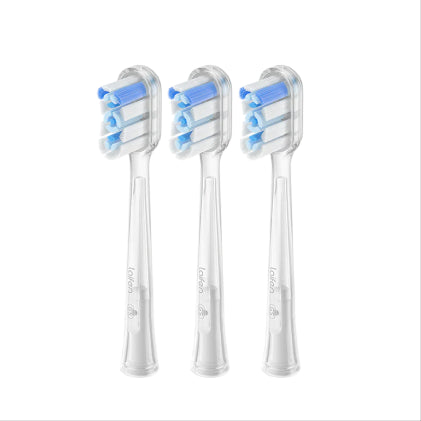
In this article
Curious about where the toothbrush comes from? Since we use a toothbrush twice a day, learning about its origins is quite fascinating. This small tool has a surprisingly long history. Thousands of years ago, people sought ways to keep their teeth clean. However, the modern toothbrush we use today isn’t that old. In this article, you’ll learn who invented the toothbrush, how technology has evolved over the years, and all about electric toothbrushes.
Who Invented the First Toothbrush?
The first toothbrush didn’t appear overnight. Centuries ago, people used chewing sticks to clean their teeth. Around 3000 years ago in Egypt, worn-down twigs were quite popular. Similarly, in China, people attached pig bristles to bamboo handles to scrub their teeth. It might not sound very appealing, right?
The modern toothbrush made its debut in the 18th century. A British man named William Addis came up with the idea while he was in prison—yes, you read that correctly! While behind bars, Addis used a bone and drilled small holes into it to hold pig bristles in place. This rudimentary design became the predecessor of today’s toothbrush.
After his release from prison, Addis began manufacturing toothbrushes, sparking public excitement. And so, the journey of the toothbrush began, continuing with us to this day.
Who Invented the First Electric Toothbrush?
The electric toothbrush took a while to make its way into our bathrooms. In the 1950s, Dr. Philippe-Guy Woog from Switzerland invented the first electric toothbrush, called "Broxodent." It was originally designed to help people who had difficulty brushing properly after surgery.
Broxodent entered the U.S. market in 1960 and quickly gained popularity. Of course, the early electric toothbrushes were quite simple compared to the advanced models we have today. However, the idea behind them was revolutionary: brushing should be easier and more effective.
Electric Toothbrush Technology
Since the 1950s, electric toothbrushes have evolved significantly. Today, they go beyond simple vibrating brushes to high-tech devices that make oral care easier and more effective.
Sonic Toothbrushes
The first sonic toothbrushes were introduced in the 1980s. These brushes use sonic waves, with bristles that move extremely fast. This high speed helps the brush reach even the most difficult areas in the mouth, making it a popular choice for many.
Rotating Toothbrushes
Alongside sonic brushes, there are also rotating toothbrushes. These feature round brush heads that move in quick circular motions, effectively removing plaque and stains. Rotating toothbrushes offer a gentle yet thorough clean.
Smart Technology
The latest generation of electric toothbrushes integrates smart technology. These brushes can connect to your smartphone and provide real-time feedback on your brushing habits. Are you applying too much pressure? Missing spots? Your toothbrush will alert you! These features help improve brushing techniques and ensure every part of your mouth is properly cleaned.
Advantages of Electric Toothbrushes
- More thorough cleaning
- Gentle on gums and teeth
- Ideal for people with limited mobility
- Built-in timers to ensure proper brushing time
- Various brush heads to meet different needs
Alternatives to Electric Toothbrushes
Electric toothbrushes offer many benefits, but there are alternatives for those who prefer a simpler routine. Whether it's a manual toothbrush or another oral hygiene tool, the key is to maintain consistent and proper oral care habits.
Don’t Want to Buy an Electric Toothbrush?
Many people still prefer the classic manual toothbrush, and others opt for more eco-friendly alternatives like bamboo toothbrushes. Regardless of whether you use an electric or manual toothbrush, what truly matters is consistent cleaning. Using the proper technique and dedicating enough time to dental care is essential.
Healthy Dental Care
-
Brush Twice a Day
Make it a habit to brush your teeth every morning and night. -
Use Floss or Interdental Brushes
Clean between teeth to remove plaque where your toothbrush can’t reach. -
Visit Your Dentist Regularly
Routine dental check-ups are essential for maintaining good oral health. -
Maintain a Healthy Diet
Choose foods that support strong teeth and avoid excessive sugar. -
Avoid Foods with Strong Staining Properties
Limit consumption of coffee, tea, red wine, and other highly pigmented foods.
Whether you use a manual or electric toothbrush, following these key practices ensures strong, healthy teeth for the long run.
The Future of Toothbrushes
Technology is constantly evolving, and even the toothbrush has no limits. Experts are already working on new models that aim to be smarter and more efficient. In the future, toothbrushes may be able to monitor your oral health, alerting you when it’s time to see a dentist.
Researchers are also experimenting with toothbrushes that automatically clean every area of your mouth, requiring no effort from the user. It’s an exciting development to watch!
Conclusion – Who Invented the Toothbrush?
The toothbrush plays a crucial role in our hygiene. From the simple chewing sticks of ancient Egypt to pig bristle brushes in China, and finally to modern electric toothbrushes, the journey of the toothbrush is truly fascinating.
Today, we have a variety of models to choose from. Whether you prefer manual or electric, thorough and regular brushing remains essential. The future promises even more exciting innovations—who knows, maybe you’ll soon be brushing your teeth automatically!























